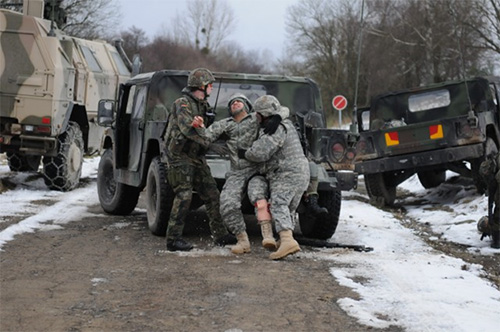Modern conflicts have contributed to increased blast casualty rates and although contemporary military medicine has continued to make significant strides towards addressing such injuries, Service members still experience a variety of negative health outcomes. For example, blast-related pelvic trauma due to dismounted blasts (i.e., those occurring while on foot) are severe combat injuries that can place Service members at risk for non-compressible vascular injuries (i.e., venous hemorrhage or arterial rupture) or even death. Although pelvic trauma is prevalent in combat environments, there is little scientific literature available with respect to blast-related pelvic fractures and vascular injuries and their associations with mortality in military populations. This information is vital to the optimization of emergency care protocols and to the understanding of injury mechanisms to inform better protection strategies.
Dr. Iain Rankin and his colleagues at The Royal British Legion Centre for Blast Injury Studies, Department of Bioengineering at Imperial College London (London, United Kingdom)1 performed a retrospective study using the U.K. Joint Theater Trauma Registry to examine the relationship between pelvic injury and mortality. The authors identified 159 male patients who had sustained pelvic injuries while deployed to either Iraq or Afghanistan between 2003 and 2014. The mortality rate was 36 percent. The majority of pelvic injuries were due to dismounted blasts (86 percent) relative to mounted blasts (14 percent). The researchers highlight a trend between pelvic vascular injuries and overall mortality rate: amongst the injuries considered (traumatic amputation, perineal injury, unstable fractures, pelvic vascular injury, and combinations of them), pelvic vascular injury alone or combined with other injuries had the highest relative risk of mortality. Computed tomography (CT) imaging of the 103 dismounted blast casualties demonstrated that lateral displacement of the pelvis was also significantly related to the development of pelvic vascular injuries.
Early intervention is essential to the treatment of blast-related pelvic injuries; within this cohort, 62 percent of the fatalities were unable to receive medical attention before succumbing to their injuries.1 Pelvic fractures, traumatic amputations, and perineal injuries were found to increase the risk of pelvic vascular injuries three-fold, with pelvic vascular injuries carrying the highest relative risk of death both in conjunction with and when compared to other injury categories. Interventional measures for pelvic vascular injuries currently include hemorrhage control and surgical management. Additionally, the authors suggest that the lateral displacement of the pelvis exhibited by these patients supports a previously-published hypothesis of lower limb flail as a mechanism of primary blast injury to the pelvis,2 which has implications for injury modeling and the development of blast protection strategies.

1 Rankin IA, Webster CE, Gibb I, Clasper JC, Masouros SD. "Pelvic injury patterns in blast: Morbidity and mortality." J Trauma Acute Care Surg. 2020;88(6):832-838.
2 Rankin IA, Nguyen TT, Carpanen D, Clasper JC, Masouros SD. "Restricting Lower Limb Flail is Key to Preventing Fatal Pelvic Blast Injury." Ann Biomed Eng. 2019;47(11):2232-2240.
Your 15 minute session will timeout in approximately 10 minutes.
If you're in the middle of entering information, please close this warning and save your progress (if possible) or finish up your task.
If your session fully times out, you will lose any un-saved work.
Your current Blast Injury Research Program session has expired.
Your next click will take you away from the private area, and you will lose any work you have in-progress.
Please enter your email address, and try again.